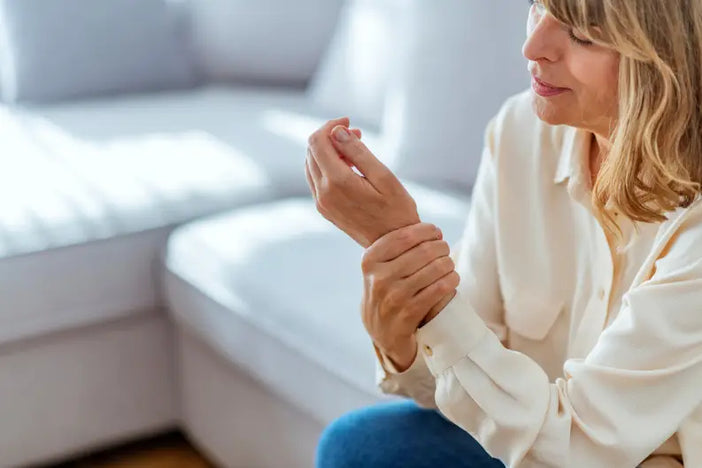How To Identify And Treat Diabetes And Joint Pains?

If sugar levels are not maintained at safe levels, people diagnosed with type 2 diabetes have a high potential for developing complications. These complications can cause autoimmune disorders, diabetic neuropathy, excess weight, chronic musculoskeletal conditions, and others. In further text, you can discover a way to identify and treat joint pains caused by diabetes.
Ask yourself the subsequent questions. The questions can help you address several more frequent symptoms people have when diabetes affects their ligaments, muscles, tendons, or joints. If you answer “yes” to any, make sure to speak to your doctor.
- Is the movement of your hands impaired by stiffness?
- Are your fingers “locked” in certain positions?
- Do you have numbness or tingling in your arms, hands, or legs?
- Are your shoulders stiff and have a limited range of motion?
- Do you have muscle pain or swelling?
Can type 2 diabetes make your joints hurt? Why does diabetes cause joint pain and what causes joint problems for people with diabetes?
Diabetes and joint pain are considered independent conditions. Anyhow, if you have type 2 diabetes, you are at an increased risk of developing damage to your bones and joints. Therefore, any everyday activity or movement can be rather more difficult to complete and appreciate.
The age of the patient, their glucose levels, and duration of disease are conditioning the intensity of most diabetes-related joint diseases. Further reading of this article will help you understand what causes people with type 2 diabetes to experience joint damage and pain.
When blood sugar levels are not balanced, diabetes can cause changes in your musculoskeletal system. This system is made up of bones, muscles, joints, tendons, and ligaments. Other factors, such as arterial disease, obesity, and nerve damage are called diabetic neuropathy. They can serve as accelerators to the development and cause joint issues. The medical term for such problems is diabetic arthropathy.
Decreased sensation in the joints can happen because of diabetic peripheral neuropathy. It can cause chronic and progressive arthropathy, which happens because of increased instability, range of motion of joints, increased laxity of ligaments, and ongoing microtraumas with poor healing capacity. That can damage joints over time.
Increased blood sugar that occurs with diabetes also causes structural and molecular changes to the cartilage within joints. However, usually, there is no single clear cause of affected joints for people with type 2 diabetes.
How to decrease joint pain when living with diabetes?
Once your healthcare provider is certain that the pain in your joints is linked with diabetes treatments can vary. Primarily you must control blood sugar levels. Depending on the stage, progression, and condition the development of the syndrome can be slowed.

What are the symptoms of diabetic arthropathy?
Joint pain caused by diabetes, or diabetic arthropathy, can affect any joint in the human body. Including those in fingers, hands, feet, shoulders, neck, and spine. People with diabetes tend to experience a wide variety of symptoms, such as
- Joint pain – gradual onset and escalation
- Joint stiffness
- Swelling
- Tight, thick skin
- Changes in the feet
- Painful shoulders
- Carpal tunnel syndrome
- Trigger finger
Diabetic arthropathy comes in various forms:
- Rheumatoid arthritis
- Osteoarthritis
- Charcot’s Joint
Want to learn about diabetes management? Check out Cura Life’s blog post on the future of diabetes management.
What is Charcot arthropathy?
Charcot arthropathy is commonly known as Charcot foot and ankle or Charcot neuroarthropathy. Common syndrome in patients who have peripheral neuropathy. Charcot arthropathy is manifesting as fractures and dislocations of bones and joints with minimal or no known trauma. In other words, they have a loss of sensation, in their feet and ankles.
What is diabetic cheiroarthropathy?
Diabetic cheiroarthropathy is commonly known as limited joint mobility syndrome or a stiff hand syndrome. This condition is mostly affecting the skin and was one of the earliest known complications of diabetes.
The hands and fingers are characteristically waxy, with thickened skin and limited joint mobility. This condition is leading to flexion contractures. It can be an indicator of other diabetes-related complications.
Described in adolescents with type 1 and in adults with type 2 diabetes mellitus, and it is observed in roughly 30% of diabetic patients with longstanding disease. It was first documented in 1974.
In the fingers, diabetic cheiroarthropathy can cause joints to have extremely limited mobility. That the patient is unable to fully extend the fingers in an attempt to straighten the hand. Diabetic cheiroarthropathy usually affects both hands.
Most patients experienced stiffness that begins in the little finger and spreading to the thumb. At times, smaller, more fragile joints are affected by it. Larger joints only affected patients with more severe cases of diabetes. Patients with a longer history of diabetes are at greater risk of Cheiroarthropathy.

What are the 14 ways to reduce joint pain with diabetes?
Having joint pain caused by diabetes can be unpleasant, but luckily there are treatments available to help minimize pain and discomfort. Treating the problem in the early stages can help a person avoid complications such as malformations and joint damage.
1. Control your blood sugar
Checking your blood sugar and maintaining a log every day will help you understand what it takes for your body to be in balance.
2. Lose weight
Keeping a moderate weight and waistline will help you maintain normal blood sugar levels and decrease your risk of developing complications while having diabetes.
3. Have a healthy diet
Adopting a diabetes nutrition plan can help. Having consistent meals, at the same time every day is crucial. Good eating habits can help you improve your quality of life and control diabetes.
4. Keeping active
To prevent joint and muscle problems and help reduce joint pain, you must keep moving. The choice of your physical activities should vary. Try alternating between stretching, aerobics, and resistance training. That way you can relax and strengthen muscles, promoting flexibility and function. Water exercising and cycling are low-impact activities, making them great for people with type 2 diabetes that are already experiencing some joint pain.
5. Stop smoking
Quitting smoking is particularly important. Smoking tightens the blood vessels that supply nutrients to the peripheral nerves and make neuropathic symptoms worse.
6. Limiting or avoiding consumption of alcohol
If you have diabetes, consuming alcohol can cause your blood sugar to either rise or fall. In addition, alcohol has quite the number of calories. If you decide to drink, do it occasionally. Make sure to drink it only when your diabetes and sugar levels are well-controlled and stable. It is good to consult your healthcare provider regarding alcohol consumption.
7. Acupuncture
Acupuncture is targeting the nervous system, inducing biophysical signals to allow for healing responses.
8. Use hot and cold therapy
Basic heat therapy or thermotherapy can involve the use of a hot water bottle, a warm bath, or pads that can be heated in a microwave. For cold therapy or cryotherapy, you can use a bottle full of cold water or a pad cooled in the freezer. You can always use some other creative way.
In some cases, alternating heat and cold can help because it will increase the blood flow to the injury area. Heat and cold treatment might not be suitable for people with diabetic neuropathy or another condition that reduces sensations of hot or cold, like Raynaud’s syndrome.
9. Physical and occupational therapy
Treatments like physical therapy can help heal diabetes-related skin problems faster than without it. With regular practice, your physical therapist can help you improve your ability to move, perform daily activities and reduce pain.
10. Electrical Nerve Stimulation
Electrical stimulation, also called neuromodulation, uses electricity to decrease pain sensations. For some people, neuromodulation treatments can reduce pain with a minimal number of risks. This treatment is offered as an alternative to medication. Neuromodulation is often used for treating arthritis pain.
11. Low intensity "cold" lasers
Cold laser therapy is used to treat wounds that are difficult to heal, frequently caused by diabetes. If you are interested in cold laser therapy, speak with a doctor to understand if it makes sense to you.
12. Medication
Most of these conditions can be successfully treated with anti-inflammatory medications, steroid injections, or other medical therapies.
13. Surgery
Surgical intervention can often provide immediate relief but it comes as the last option considering the stress it causes for the body.

What can you do about knee pain caused by your unmanaged or uncontrolled type 2 diabetes?
Always call your doctor if you are experiencing pain, swelling, redness, or numbness in your knee. These symptoms need to be examined as soon as possible. If you have type 2 diabetes or believe you may be at risk, consider talking to your doctor about your personal risk factors for joint pain.
Once your healthcare provider is certain the pain in your knee has a diabetic background treatment could be focused on pain control with oral medications or topical cream.
Can you beat joint problems and live with diabetes pain-free?
Managing your diabetes is the key to beating diabetes-related joint pain. Meaning-taking measures to keep your blood sugar levels balanced can secure you from further complications. High sugar levels can thicken and reduce diabetics’ collagen. With additional glucose sticking to the joint surfaces. Together, this stickiness and degradation interfere with movement and place people with diabetes at a greater risk of falls, injury, and pain.
Want to learn more about how you can support your lifestyle? Join our community.



